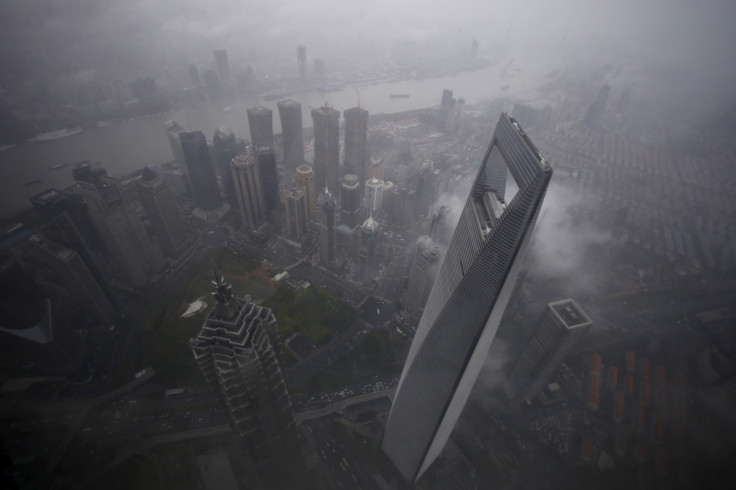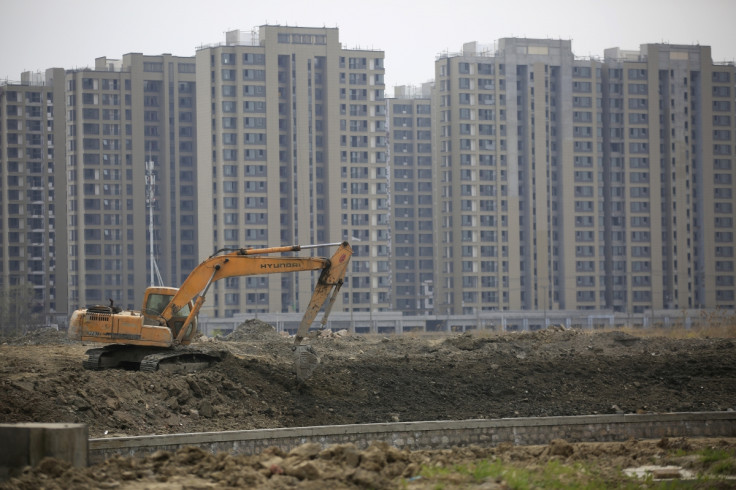China's Atlantis: How Shanghai is sinking under the weight of its tallest towers
Could China's financial hub soon be underwater?
On a warm spring day in Pudong, confused tourists mill around the base of the second tallest building in the world, the Shanghai Tower, trying to get inside. Just a few days earlier Chinese media announced that the perennially delayed building was finally open, yet doors are crudely sealed with heavy duty locks, entrances barricaded and security guards keep a watchful eye on the crowds.
It is not the first time that the Gensler-designed Shanghai Tower has been opened in 2016. In March, it was announced that the building was finally finished and in April that its 561m-high observation deck was open to the public. But when IBTimesUK visited on April 30, staff revealed that the only part of the building currently accessible is the basement, with the deck delayed until July, possibly even later.
Delays to tall buildings are not unusual: Dubai's Burj Khalifa – the world's tallest tower – was held up for two years before it was finally opened in 2010 after a bailout from wealthy Abu Dhabi. On that scale, the Shanghai Tower is on track: it was originally due to be finished in 2014, then 2015 and despite the confusion at the site in April 2016, there is a feeling that the final touches are underway.
But it is difficult to say: Gensler, the designers of the project, did not respond to IBTimesUK's requests for comment and the last entry on the company's official Shanghai Tower blog dates from February 2015.

There have been rumblings about the project in the past. In 2014, the Wall Street Journal reported that the developer was looking to hire a leasing agent to help it fill the staggering 220,000 square metres of office space that the Shanghai Tower will provide. When work began in 2008 amid an economic boom, that would not have seemed a difficult proposition, but China is a different place today.
Still, the security surrounding the tower – including the barricades, guards and locked doors – is perhaps clearer. In 2014, climbers Vadim Makhorov and Vitaliy Raskalov made headlines after scaling the tower without using ropes and posting the video on the internet. The feat led to a number of copycat attempts, including one a month later by two Chinese climbers and then again by a foreign team in 2015.
Until the early 1990s, Pudong's Lujiazui district was little more than a smattering of warehouses and low-level commercial buildings in a sharp bend of the Huangpu River, but today the zone is Shanghai's roaring financial hub. It contains the city's four tallest towers: the Shanghai Tower (623m), Shanghai World Financial Centre (492m), the Oriental Pearl Tower (470m) and the Jin Mao Tower (421m).
Such massive developments in a small area mirrors the trajectory of Shanghai itself. Unlike Beijing, which dates back some 3,000 years, Shanghai was little more than a fishing village until the early 17<sup>th century when its development as a port began under the late Qing Dynasty. By 1900 the population stood at one million and by the 1930s Shanghai was one of the world's largest cities in the world .
That escalated with the opening of China after the death of Mao Zedong in 1976 and ballooned from 1989 onwards when Jiang Zemin, a Shanghai native, took power in China. It was Jiang who gradually allowed Lujiazui to become the free trade zone and economic hub that it is today. Chinese population figures are frequently disputed, but official tallies have Shanghai's 23.9 million as of 2014.
Many of the towers that dominate the landscape, not just of Lujiazui but of the rest of Shanghai, help to house those people. Others – such as the aforementioned iconic big four – serve a more commercial function, either by hosting both international and local firms or demonstrating the city's success. Whatever their function, critics have long suggested that Shanghai's skyscrapers could be its downfall.
Many experts feel that Shanghai has become just too heavy not to continue sinking.
Shanghai, like much of China, is situated on a flood plain and estimates suggest that the city has sunk by over 2.5 metres in the last 100 years. At one point during the 1960s, Shanghai was sinking 10cm per year, leading to warnings that the city could be below sea level by 1999. In other areas of China the issue is even more acute: Cangzhou, near Beijing, has sunk by 2.4m in just 40 years.
It is not just building that has led to the crisis but so has providing for China's expanding cities. As much as 80% of Beijing's water supply comes from the ground, and as the authorities pump it out, so the cities sink.
A report published in 2012 by the China Geological Environmental Monitoring Institute revealed that it would take 10,000 years to replenish the 100 billion cubic metres of water that has been pumped out of the ground since the 1970s. While in Shanghai, the China Daily reported that the authorities were now pumping water back into underground reserves to try and rectify the problem.
"Although the current (subsidence) rate will keep the city above sea level for more than 400 years, it still holds several potential dangers. It has already forced the city to raise its floodwall again and again," Li Qinfen, a professor at the Shanghai Institute of Geological Survey, said.
The role of buildings such as the Shanghai Tower in Shanghai's sink was highlighted in 2012, when China-based blog China Smack shared online pictures of cracks appearing in the ground around the Lujiazui. Later that year, the China Daily reported that massive subsidence was being seen in more than 50 cities and was costing local authorities in Shanghai CH¥20m (£2m, $3m) per year.

Hisham Youssef, an architect that has spent the last five years working in Shanghai, said that the government could address the issue with tighter controls on the use of underground water, new development regulations and a cohesive pan for an infrastructure project to reverse the subsidence, it may still have to accept its sink as a fact of life: "Many experts feel that Shanghai has become just too heavy not to continue sinking," he said.
"Taking the long view on an issue that does not have immediate ramifications, especially in Shanghai, a city that is in a big way about immediate gratifications, will take courage and coordination to save the very city that shines today as a beacon of China's prosperity, for generations to come," he added.
There are signs, however, that the Shanghai Tower has been designed with the issue of subsidence in mind. Gensler took a two-pronged approach to the base of the tower, drillingpilons 200 metres into the land below Shanghai, while also using floating platforms as artificial bedrock. That will need to become the rule in the years ahead, Youssef said, to provide additional protection against sinking.
But 2016 finds Shanghai – and China – stuck between a rock and a hard place: while its predicament is a huge environmental concern, the growth of cities is organic and Chinese will continue to move to them in huge numbers. Likewise buildings such as the Shanghai Tower are prestige projects and there is little chance of the authorities rolling back on the super-tall tributes to the new China.
© Copyright IBTimes 2025. All rights reserved.






















